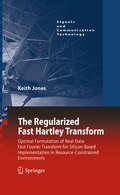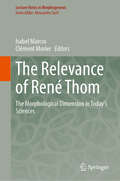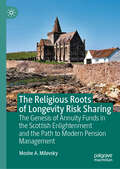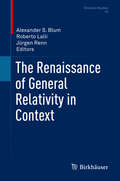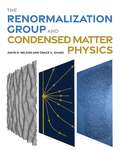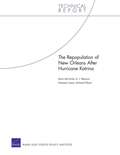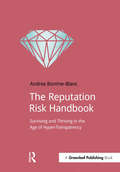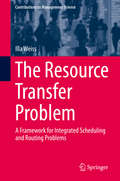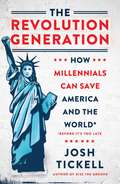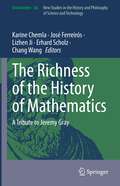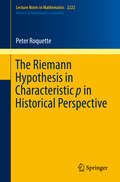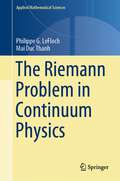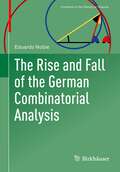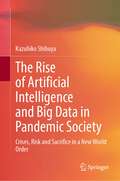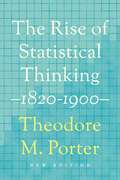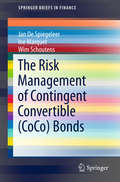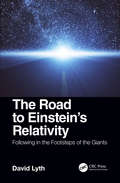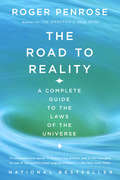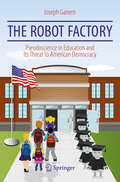- Table View
- List View
The Regularized Fast Hartley Transform
by Keith JonesThe Regularized Fast Hartley Transform provides the reader with the tools necessary to both understand the proposed new formulation and to implement simple design variations that offer clear implementational advantages, both practical and theoretical, over more conventional complex-data solutions to the problem. The highly-parallel formulation described is shown to lead to scalable and device-independent solutions to the latency-constrained version of the problem which are able to optimize the use of the available silicon resources, and thus to maximize the achievable computational density, thereby making the solution a genuine advance in the design and implementation of high-performance parallel FFT algorithms.
The Relationship of Affect and Creativity in Mathematics: How the Five Legs of Creativity Influence Math Talent
by Eric Mann Scott ChamberlinThe Relationship of Affect and Creativity in Mathematics explores the five legs of creativity—Iconoclasm, Impartiality, Investment, Intuition, and Inquisitiveness—as they relate to mathematical giftedness. This book:Discusses these affective components relevant to mathematical learning experiences.Shares how affective components impact students' creative processes and products.Shows the influence of learning facilitators, including teachers, afterschool mentors, and parents.Describes facilitating environments that may enhance the likelihood that creative process and ultimately product emerge.Utilizes the expertise of two young scholars to discuss the practical effects of affect and creativity in learning experiences.This practical, research-based book is a must-read for stakeholders in gifted education, as many advanced students are underidentified in the area of creativity in mathematics.
The Relevance of René Thom: The Morphological Dimension in Today’s Sciences (Lecture Notes in Morphogenesis)
by Isabel Marcos Clément MorierThe body of work presented in this book comes from research carried out since 2017 as part of the international "Actualité de René Thom" project. This project was initially entitled "Morphology and qualitative dynamics: Knowledge of forms / Forms of knowledge". Subsequently, the name "Relevance of René Thom" was chosen for its clarity and evocative power.The aim of this research project is to promote the scientific relevance of René Thom's thinking on forms, and to demonstrate the importance of his method and discoveries. It is based on discussions of Thom's thinking and the method he proposes - i.e., to seek out dynamic structures in order to understand changes of form in nature and at the human-social level, to explain the transformation of these dynamic forms, to study the morphologies of process in various fields in order to advance scientific knowledge...The relevance of this thinker has manifested itself in the form of monthly sessions of a research seminar, held from 2017 to 2022, as well as in the form of international congresses (2018, 2019), bringing together the greatest friends and continuators, both of the work of René Thom himself, and of reflection on morphogenetic dynamics in the most diverse disciplines. This created a space for dialogue and listening between the exact sciences and the social and human sciences. Indeed, the fields of study are necessarily interdisciplinary, since, as René Thom teaches us, morphological organization, or form, in its exchanges with matter, must be considered as "independent" of its substrate, i.e. the environment in which this morphogenesis unfolds. Finally, this book marks a symbolic moment: it takes shape in the year that marks the centenary of the birth of René Thom, who was born in the French town of Montbéliard in 1923. To mark this centenary (1923-2023), a number of initiatives have been launched to celebrate the discoveries and advances of this mathematician-philosopher, ashe liked to call himself… The publication of the present book is one more, which we hope will shed light that will stimulate the morphological gaze Thom so urged us to adopt.
The Religious Roots of Longevity Risk Sharing: The Genesis of Annuity Funds in the Scottish Enlightenment and the Path to Modern Pension Management
by Moshe A. MilevskyThis book presents a unique historical study on the origins of longevity risk management and its links to religious institutions in the eighteenth century. Throughout history, monarchs, affluent patrons, and wealthy benefactors routinely pledged to provide their devotees with pensions or life annuities, mirroring the biblical concept of ‘daily bread for life’. Until the eighteenth century, however, the uncertainty around the longevity of beneficiaries’ lives and the difficulty of budgeting for random financial obligations had posed economic challenges that often led to insufficient funding and high default rates. This book narrates the genesis of longevity risk pooling and the first successfully funded annuity scheme in history, an eventual prototype for national pension plans around the world. It examines how a group of Protestant clergymen, scientists, and intellectuals associated with the Presbyterian Church of Scotland pioneered innovative methods for setting up a reversionary annuity and widow’s pension plan, guided by actuarial principles. Unknown to many, the economist Adam Smith, and other literati of the Scottish Enlightenment, invested in this novel annuity. Illuminating the social and theological contexts of this scheme, the book argues that religious belief played a critical role in the development of best practices around the prudent management of longevity risk. The practices, values and beliefs in divine probabilities were at the heart of these thought leaders’ confidence in long-term financial projections. Shedding light on this fascinating aspect of actuarial history by an examination of the archival records, while also linking to contextual discussions of modern pension challenges, this book will be of interest to scholars and readers interested in finance, insurance, pensions, and religion.
The Renaissance of General Relativity in Context (Einstein Studies #16)
by Jürgen Renn Roberto Lalli Alexander S. BlumThis contributed volume explores the renaissance of general relativity after World War II, when it transformed from a marginal theory into a cornerstone of modern physics. Chapters explore key historical processes related to the theory of general relativity, in addition to presenting a thorough treatment of the relevant science behind these episodes. A broad historiographical framework is introduced first, thus providing the broad context in which the given computational approaches and case studies occurred. Written by an international and interdisciplinary group of expert authors, these chapters will bring readers to a more complete understanding of Einstein’s theory. Specific topics include:Social and citation networksThe Fock-Infeld disputeWheeler’s turn to gravitation theoryThe position of general relativity in theories of fundamental interactionsThe pursuit of a quantum theory of gravityThe emergence of dark matter in relation to cosmological modelsInstitutional frameworks for gravitational wave search in EuropeThe Renaissance of General Relativity in Context is ideal for historians, philosophers, and sociologists of science. Students and researchers in physics will also be interested in the topics explored.
The Renormalization Group and Condensed Matter Physics
by David R. Nelson Grace H. ZhangA graduate-level entrée to the application of renormalization group theory to condensed matter physicsRenormalization group ideas have had a major impact on condensed matter physics for more than a half century. This book develops the theory and illustrates the broad applicability of the renormalization group to major problems in condensed matter physics. Based on course materials developed and class-tested by the authors at Harvard University, the book will be especially useful for students, as well as researchers in condensed matter physics, soft matter physics, biophysics, and statistical physics. After reviewing Ising models, lattice gases, and critical point phenomena, the book covers quantum critical phenomena; the statistical mechanics of linear polymer chains; fluctuating sheet polymers; the dynamics associated with the Navier-Stokes equations and simplified models of randomly stirred fluids; the properties of &“active matter&”; and more.Explores the broad applicability of renormalization groups to condensed matterCovers critical phenomena in different dimensions, quantum critical points, polymer physics and flexural phonons in free-standing graphene, nonequilibrium fluid dynamics, and moreProvides a modern, physics-centered entrée, suitable for both course use and self-studyFeatures material ideal for graduate-level students as well as researchersIncludes exercises throughoutOffers a solutions manual for exercises (available only to instructors)
The Repopulation of New Orleans After Hurricane Katrina
by Kevin F. Mccarthy Michael Pollard D. J. Peterson Narayan SastryIn November 2005, New Orleans city leaders asked RAND to estimate the repopulation of the city in the aftermath of Hurricane Katrina. The Bring New Orleans Back Commission needed estimates of the city's population in the immediate and near-term future to guide the redevelopment planning process. An assessment of flood damage to housing based on the depth of floodwater and the likely pace of reconstruction of damaged housing guided the estimates.
The Reputation Risk Handbook: Surviving and Thriving in the Age of Hyper-Transparency
by Andrea Bonime-BlancThis book will show you how to build a sustainable reputation risk management framework and how to handle your next reputation risk crisis. It will help you identify ways in which reputation risk can impact bottom line, and then show you how to set up a framework for turning that risk into an opportunity for good, sustainable business. Reputation risk is a strategic risk and a potentially material risk, all the more so in the "age of hyper-transparency". This needs to be clearly understood by both management and boards of directors so that the people tasked with reputation risk have the support they need to align their reputation risk management with business strategy and planning. The Reputation Risk Handbook provides a clear framework to identify, manage and resolve reputation risk, including: a clear description of what reputation risk is and how it fits within the pantheon of corporate and institutional risk and strategic management; a practical process for creating early warning systems and on-going management and monitoring of reputation risks; techniques for aligning reputation risk management with business strategy and business planning; several case studies, including examples of when reputation risk management has gone wrong; examples of how to manage specific reputation risks successfully or deal with a reputation risk crisis. The Reputation Risk Handbook is not just for practitioners – those who manage risk and reputation directly – but for those who have oversight of risk management – namely boards, their committees and the c-suite. In addition to a framework for practitioners, the book provides specific suggestions for boards, including questions to ask management and what to look for within their organizations.
The Resource Transfer Problem: A Framework For Integrated Scheduling And Routing Problems (Contributions to Management Science)
by Illa WeissThe resource transfer problem (RTP) is a modeling and solution framework for integrated complex scheduling and rich vehicle routing problems. It allows the modeling of a wide variety of scheduling problems, vehicle routing problems, their combination with integrated problems, as well as various specific requirements and restrictions arising in practical scheduling and vehicle routing. Based on the unifying resource transfer problem framework, this book proposes a generic constraint propagation approach that exploits the specific structure of scheduling and routing problems.
The Respiratory System in Equations
by Bertrand MauryThis book proposes an introduction to the mathematical modeling of the respiratory system. A detailed introduction on the physiological aspects makes it accessible to a large audience without any prior knowledge on the lung. Different levels of description are proposed, from the lumped models with a small number of parameters (Ordinary Differential Equations), up to infinite dimensional models based on Partial Differential Equations. Besides these two types of differential equations, two chapters are dedicated to resistive networks, and to the way they can be used to investigate the dependence of the resistance of the lung upon geometrical characteristics. The theoretical analysis of the various models is provided, together with state-of-the-art techniques to compute approximate solutions, allowing comparisons with experimental measurements. The book contains several exercises, most of which are accessible to advanced undergraduate students.
The Revolution Generation: How Millennials Can Save America and the World (Before It's Too Late)
by Josh TickellFrom the activist and Sundance Award-winning filmmaker of Fuel and Kiss the Ground comes an ambitious book showcasing the captivating stories of Millennial change-makers in order to empower and motivate today’s young adults to rise up to their potential for greatness.With eye-opening research and inspiring interviews, The Revolution Generation is the first in-depth exploration of the world-changing activism and potential of people born between 1980 and 2000. Labeled Generation Y or Millennials, theirs is the first digitally fluent generation. From sex and dating, to parental relationships, to jobs and the economy, Millennials live within a dynamic interplay of technological advances and real world setbacks. Their connectivity and global awareness have created astonishing new opportunities, but have also come at a time of peril. According to the United Nations, today’s youth face the ten largest global crises in human history (including the sixth major species extinction, a rapidly changing climate, and a worldwide refugee crisis). In no uncertain terms, the future of humanity rests on their shoulders. While these challenges may be daunting, Millennials are part of the largest, most educated, most digitally plugged-in generation to date and The Revolution Generation elucidates their often-overlooked strengths and shows how they can build a brighter, more sustainable and democratic future for themselves—and all of humanity. The Revolution Generation is also soon to be a full-length documentary featuring Bernie Sanders, Shailene Woodley, Rosario Dawson, and more.
The Richness of the History of Mathematics: A Tribute to Jeremy Gray (Archimedes #66)
by Karine Chemla José Ferreirós Erhard Scholz Lizhen Ji Chang WangThis book, a tribute to historian of mathematics Jeremy Gray, offers an overview of the history of mathematics and its inseparable connection to philosophy and other disciplines. Many different approaches to the study of the history of mathematics have been developed. Understanding this diversity is central to learning about these fields, but very few books deal with their richness and concrete suggestions for the “what, why and how” of these domains of inquiry. The editors and authors approach the basic question of what the history of mathematics is by means of concrete examples. For the “how” question, basic methodological issues are addressed, from the different perspectives of mathematicians and historians. Containing essays by leading scholars, this book provides a multitude of perspectives on mathematics, its role in culture and development, and connections with other sciences, making it an important resource for students and academics in the history and philosophy of mathematics.
The Riemann Hypothesis for Function Fields
by Machiel Van FrankenhuijsenThis book provides a lucid exposition of the connections between non-commutative geometry and the famous Riemann Hypothesis, focusing on the theory of one-dimensional varieties over a finite field. The reader will encounter many important aspects of the theory, such as Bombieri's proof of the Riemann Hypothesis for function fields, along with an explanation of the connections with Nevanlinna theory and non-commutative geometry. The connection with non-commutative geometry is given special attention, with a complete determination of the Weil terms in the explicit formula for the point counting function as a trace of a shift operator on the additive space, and a discussion of how to obtain the explicit formula from the action of the idele class group on the space of adele classes. The exposition is accessible at the graduate level and above, and provides a wealth of motivation for further research in this area.
The Riemann Hypothesis in Characteristic p in Historical Perspective (Lecture Notes in Mathematics #2222)
by Peter RoquetteThis book tells the story of the Riemann hypothesis for function fields (or curves) starting with Artin's 1921 thesis, covering Hasse's work in the 1930s on elliptic fields and more, and concluding with Weil's final proof in 1948. The main sources are letters which were exchanged among the protagonists during that time, found in various archives, mostly the University Library in Göttingen. The aim is to show how the ideas formed, and how the proper notions and proofs were found, providing a particularly well-documented illustration of how mathematics develops in general. The book is written for mathematicians, but it does not require any special knowledge of particular mathematical fields.
The Riemann Hypothesis: The Greatest Unsolved Problem in Mathematics
by Karl SabbaghHistorical discussion of the still unsolved problem of the Riemann Hypothesis.
The Riemann Problem in Continuum Physics (Applied Mathematical Sciences #219)
by Philippe G. LeFloch Mai Duc ThanhThis monograph provides a comprehensive study of the Riemann problem for systems of conservation laws arising in continuum physics. It presents the state-of-the-art on the dynamics of compressible fluids and mixtures that undergo phase changes, while remaining accessible to applied mathematicians and engineers interested in shock waves, phase boundary propagation, and nozzle flows. A large selection of nonlinear hyperbolic systems is treated here, including the Saint-Venant, van der Waals, and Baer-Nunziato models. A central theme is the role of the kinetic relation for the selection of under-compressible interfaces in complex fluid flows. This book is recommended to graduate students and researchers who seek new mathematical perspectives on shock waves and phase dynamics.
The Riemann Zeta-Function: Theory and Applications (Dover Books on Mathematics)
by Aleksandar IvicThis extensive survey presents a comprehensive and coherent account of Riemann zeta-function theory and applications. Starting with elementary theory, it examines exponential integrals and exponential sums, the Voronoi summation formula, the approximate functional equation, the fourth power moment, the zero-free region, mean value estimates over short intervals, higher power moments, and omega results. Additional topics include zeros on the critical line, zero-density estimates, the distribution of primes, the Dirichlet divisor problem and various other divisor problems, and Atkinson's formula for the mean square. End-of-chapter notes supply the history of each chapter's topic and allude to related results not covered by the book. 1985 edition.
The Rise and Fall of Business Firms: A Stochastic Framework on Innovation, Creative Destruction and Growth
by S. V. Buldyrev F. Pammolli M. Riccaboni H. E. StanleyAt the intersection between statistical physics and rigorous econometric analysis, this powerful new framework sheds light on how innovation and competition shape the growth and decline of companies and industries. Analyzing various sources of data including a unique micro level database which collects historic data on the sales of more than 3,000 firms and 50,000 products in 20 countries, the authors introduce and test a model of innovation and proportional growth, which relies on minimal assumptions and accounts for the empirically observed regularities. Through a combination of extensive stochastic simulations and statistical tests, the authors investigate to what extent their simple assumptions are falsified by empirically observable facts. Physicists looking for application of their mathematical and modelling skills to relevant economic problems as well as economists interested in the explorative analysis of extensive data sets and in a physics-orientated way of thinking will find this book a key reference.
The Rise and Fall of the German Combinatorial Analysis (Frontiers in the History of Science)
by Eduardo NobleThis text presents the ideas of a particular group of mathematicians of the late 18th century known as “the German combinatorial school” and its influence. The book tackles several questions concerning the emergence and historical development of the German combinatorial analysis, which was the unfinished scientific research project of that group of mathematicians. The historical survey covers the three main episodes in the evolution of that research project: its theoretical antecedents (which go back to the innovative ideas on mathematical analysis of the late 17th century) and first formulation, its consolidation as a foundationalist project of mathematical analysis, and its dissolution at the beginning of the 19th century. In addition, the book analyzes the influence of the ideas of the combinatorial school on German mathematics throughout the 19th century.
The Rise of Artificial Intelligence and Big Data in Pandemic Society: Crises, Risk and Sacrifice in a New World Order
by Kazuhiko ShibuyaThis book presents a study of the COVID-19 pandemic using computational social scientific analysis that draws from, and employs, statistics and simulations. Combining approaches in crisis management, risk assessment and mathematical modelling, the work also draws from the philosophy of sacrifice and futurology. It makes an original contribution to the important issue of the stability of society by highlighting two significant factors: the COVID-19 crisis as a catalyst for change and the rise of AI and Big Data in managing society. It also emphasizes the nature and importance of sacrifices and the role of politics in the distribution of sacrifices. The book considers the treatment of AI and Big Data and their use to both “good” and “bad” ends, exposing the inevitability of these tools being used. Relevant to both policymakers and social scientists interested in the influence of AI and Big Data on the structure of society, the book re-evaluates the ways we think of lifestyles, economic systems and the balance of power in tandem with digital transformation.
The Rise of Statistical Thinking, 1820–1900
by Theodore M. PorterAn essential work on the origins of statisticsThe Rise of Statistical Thinking, 1820–1900 explores the history of statistics from the field's origins in the nineteenth century through to the factors that produced the burst of modern statistical innovation in the early twentieth century. Theodore Porter shows that statistics was not developed by mathematicians and then applied to the sciences and social sciences. Rather, the field came into being through the efforts of social scientists, who saw a need for statistical tools in their examination of society. Pioneering statistical physicists and biologists James Clerk Maxwell, Ludwig Boltzmann, and Francis Galton introduced statistical models to the sciences by pointing to analogies between their disciplines and the social sciences. A new preface by the author looks at how the book has remained relevant since its initial publication, and considers the current place of statistics in scientific research.
The Risk Management of Contingent Convertible (SpringerBriefs in Finance)
by Jan De Spiegeleer Wim Schoutens Ine Marquet<p>This book provides an overview of the risk components of CoCo bonds. CoCos are hybrid financial instruments that convert into equity or suffer a write-down of the face value upon the appearance of a trigger event. The loss-absorption mechanism is automatically enforced either via the breaching of a particular accounting ratio, typically in terms of the Common Equity Tier 1 (CET1) ratio, or via a regulatory trigger. <p>CoCos are non-standardised instruments with different loss-absorption and trigger mechanisms. They might also contain additional features such as the cancellation of coupon payments. <p>Different pricing models are discussed in detail. These models use market data such as share prices, CDS levels and implied volatility in order to calculate the theoretical price of a CoCo bond and its sensitivities, providing the investor with insides to hedge from adverse changes in the market conditions. <p>The audience are professionals as well as academics who want to learn how to risk manage CoCo bonds using cutting edge techniques as well as all the risk involved in CoCo bonds.</p>
The Road to Einstein's Relativity: Following in the Footsteps of the Giants
by David LythCHOICE Highly Recommended Title, August 2019 <P><P>Expertly guided by renowned cosmologist Dr. David Lyth, learn about the pioneering scientists whose work provided the foundation for Einstein’s formulation of his theories of relativity, and about Einstein's groundbreaking life and work as well. <P><P>This highly readable and accessible panorama of the field delicately balances history and science as it takes the reader on an adventure through the centuries. Without complex mathematics or scientific formulae, this book will be of interest to all, even those without a scientific background, who are intrigued to find out more about what paved the way for one of our most famous physicists to push the boundaries of physics to new lengths. <P><P>Features: <li>Written by an internationally renowned physicist and cosmologist <li>Describes the life and times of Einstein and his important predecessors <li>Focuses on one of the most famous areas of science, Einstein’s Relativity Theory
The Road to Reality: A Complete Guide to the Laws of the Universe
by Roger PenroseFrom one of our greatest living scientists, a magnificent book that provides, for the serious lay reader, the most comprehensive and sophisticated account we have yet had of the physical universe and the essentials of its underlying mathematical theory.Since the earliest efforts of the ancient Greeks to find order amid the chaos around us, there has been continual accelerated progress toward understanding the laws that govern our universe. And the particularly important advances made by means of the revolutionary theories of relativity and quantum mechanics have deeply altered our vision of the cosmos and provided us with models of unprecedented accuracy. What Roger Penrose so brilliantly accomplishes in this book is threefold. First, he gives us an overall narrative description of our present understanding of the universe and its physical behaviors–from the unseeable, minuscule movement of the subatomic particle to the journeys of the planets and the stars in the vastness of time and space.Second, he evokes the extraordinary beauty that lies in the mysterious and profound relationships between these physical behaviors and the subtle mathematical ideas that explain and interpret them. Third, Penrose comes to the arresting conclusion–as he explores the compatibility of the two grand classic theories of modern physics–that Einstein’s general theory of relativity stands firm while quantum theory, as presently constituted, still needs refashioning.Along the way, he talks about a wealth of issues, controversies, and phenomena; about the roles of various kinds of numbers in physics, ideas of calculus and modern geometry, visions of infinity, the big bang, black holes, the profound challenge of the second law of thermodynamics, string and M theory, loop quantum gravity, twistors, and educated guesses about science in the near future. In The Road to Reality he has given us a work of enormous scope, intention, and achievement–a complete and essential work of science
The Robot Factory: Pseudoscience In Education And Its Threat To American Democracy
by Joseph GanemThis book exposes a disturbing misuse of the scientific method to advance policies and agendas that are in fact detrimental to both science and education. The author, a physics professor, examines two related trends in education – the practice of “data-driven” reform and the disparaging of the traditional liberal arts in favor of programs with a heavy emphasis on science and technology. Many of the reforms being foisted on educators have more in common with pseudo-science than real science. The reduction of education to a commodity, and the shilling of science as a means to enhance corporate profits, lead to an impoverished and stunted understanding of science in particular, and of education in general.How is it possible for: • schools with all students learning at grade-level to be rated as failing?• teachers to be rated as ineffective after all their students meet their learning outcomes?• rising grade-school math standards to result in more college students needing remedial math?• politicians to disparage scientists and their results but argue that more students should study science?These bizarre outcomes have happened and are the result of an education system that misuses and misrepresents math and science in the classroom and in crafting education policies. This book exposes the flawed and fallacious thinking that is damaging education at all levels throughout the United States, and makes a compelling case for rethinking the standardized, optimized, and quantified approaches in vogue in education today to accommodate the different needs of individual teachers and students.
